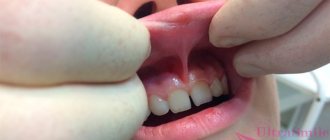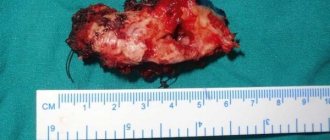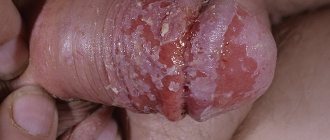After surgery, oral care requires special care and attention. The hardest part of the treatment is over, but for some time you still need to follow a number of rules that will protect your teeth and gums from new inflammations.
- After tooth extraction
- After frenuloplasty
- After implantation
Most often, special postoperative care is required during the postoperative period when installing dental implants. We will talk about it in more detail later, but for now we will list other, rarer, but also important cases when your teeth and gums require special care.
What is frenulotomy?
Frenulotomy is a simple operation, indicated for such a feature as a short frenulum of the genital organ. During this operation, the frenulum is transversely dissected and then sutured in the longitudinal direction. Thus, it stretches to its normal length. As a result, only a thin seam is visible from the inner surface of the foreskin, everything looks quite natural. The entire operation lasts no more than 20 minutes, it is not a complex surgical procedure, and is performed under local anesthesia.
Correction of the frenulum allows you to eliminate pain symptoms and eliminate the risk of ruptures and bleeding during erection. The procedure is quite simple, and the development of complications after it is extremely rare.
Where to have plastic surgery of the frenulum of the penis?
Our clinic uses modern equipment and has all the necessary tools for safe interaction with the patient. The consultation is conducted by doctors with extensive experience and knowledge in various branches of urology, who will give practical recommendations on preparing for the procedure, and then draw up the most effective plan for the rehabilitation period.
Our clinic has:
- specialized rooms for conducting hardware diagnostics;
- own laboratory for prompt research of the obtained tests;
- a modern operating room equipped with the required equipment and the necessary additional technical components.
During the operation, high-quality asepsis is used, which minimizes the risk of possible infectious complications later. A delicate approach that allows you to solve all intimate problems in a strictly confidential manner.
Indications for frenulotomy
A short frenulum can be a congenital or acquired pathology that occurs as a result of trauma to the penis or inflammatory processes. Pathology provokes:
- drooping of the head of the penis, discomfort and even pain during erection;
- premature ejaculation;
- there is a constant huge risk of tearing or rupture of the frenulum, accompanied by heavy bleeding.
It is better to perform a frenulotomy of the foreskin before the frenulum ruptures. And rupture of the frenulum if it is not long enough is almost inevitable. As soon as a man begins to perform intense friction during intercourse or masturbation, he risks tearing or tearing the frenulum. And using additional lubricant will not help here.
Some male representatives mistakenly believe that a good solution would be careful behavior and avoidance of intense friction. Even if you try to control the situation and perform only slow frictions, on a subconscious level there will still be fear and expectation of severe pain due to a tear or rupture. Of course, in such conditions it is unlikely that you will be able to get full satisfaction from sex.
Indications for surgery:
- An erect penis bends in such a way that the head bends downwards.
- Retracting the skin fold is difficult, causing pain and a feeling of tightness.
- Painful frictions cause discomfort and interfere with normal sexual intercourse.
- Frequent frenulum tears and bleeding.
- Phimosis or paraphimosis.
- Early ejaculation.
Frenulotomy is a simple operation and is often performed on an outpatient basis. Local anesthesia is usually sufficient, but in some cases general anesthesia may be necessary. The procedure does not last long, about half an hour.
Before the operation, the patient takes all the necessary tests, including HIV tests, and undergoes an examination. After this, if there are no contraindications, he goes to the operating room.
How does tongue frenuloplasty work?
Tongue frenuloplasty in adults and children can be performed traditionally surgically or using a laser. The operation is performed on an outpatient basis using local anesthesia.
In the classic version, treatment looks like this:
- old scars are excised (in cases where the frenulum was already cut in infancy) and mucous cord;
- a submucosal flap is formed;
- the place of attachment of the lingual frenulum changes;
- self-absorbable sutures are applied.
During plastic surgery of the lingual frenulum, constant monitoring of the condition of the mouths of the ducts of the submandibular and sublingual salivary glands is necessary to avoid their traumatization. Damage to the excretory ducts of the salivary glands can cause disruption of the flow of saliva.
Laser lingual frenuloplasty has a number of advantages compared to conventional surgical techniques:
- complete sterility of the surgical field;
- work in contactless mode;
- no bleeding;
- accuracy of impact;
- no need for stitches;
- comfortable conditions for the patient during tongue frenuloplasty;
- faster wound healing times.
The procedure involves the use of local anesthesia to block pain sensitivity. In the process of laser plastic surgery of the frenulum of the tongue, the doctor directs the tip of the device at it, generating a light beam - it “dissolves” excess tissue and at the same time seals and sterilizes the edges. Then a therapeutic bandage with keratoplasty - drugs to accelerate healing - is applied to the wound.
After laser plastic surgery of the frenulum of the tongue, the rehabilitation period is short, and after 2 days the patient stops paying attention to the wound.
How is frenulotomy performed?
Surgery is performed on an outpatient basis under local anesthesia for adult men, or with general anesthesia for adolescents. The duration of the manipulations is no more than 20 minutes. The patient is asked to assume a supine position on the operating table and the surgical area is disinfected.
With local anesthesia, the anesthetic is injected into the tissues of the penis, with general anesthesia - into a vein. As soon as it begins to act, the surgeon dissects the frenulum of the penis across, allowing the skin folds to straighten to the required size.
After this, the edges of the incisions are sutured with threads, which will self-resolve in the postoperative period. If there are scars, they are first excised. Upon completion, a napkin with an antiseptic is applied to the penis, which can be removed no earlier than after 12 hours.
The operation can be performed using a conventional scalpel, radio knife or laser.
Classic frenulotomy
Classic method of penile frenulum correction:
- First, a transverse dissection of the frenulum is made.
- Then the edges of the wound are stretched in the shape of a diamond.
- The final step is to adjust the skin tension and apply sutures.
The suture is applied with the same threads that are used in maxillofacial surgery. By 21 days they usually completely resolve or fall out. The finished suture is filled with surgical glue to avoid infection and separation of the edges. Such a wound can be wetted within a day; when wiping, simply blot it with a towel. If the seam is simply treated with brilliant green, then it is not recommended to wet it for about a week.
Frenulotomy using laser
Frenulotomy using a radioknife The intervention is bloodless due to the fact that the laser cauterizes the edges of the wound, eliminating bleeding.
Unfortunately, this operation has one drawback, which is the risk of divergence of the edges of the wound during an erection.
Application of radio knife
The use of a radio knife involves exposure to high-frequency radio waves. They allow the destruction of skin growths and neoplasms, excluding the impact on healthy tissues along with blood vessels. Thanks to this, there is no risk of purulent processes and hematoma. If indicated, the operation can be combined with other techniques aimed at eliminating scar tissue or narrowing the foreskin. At the same time, circumcision of the foreskin is also carried out. It is used if the surgeon notes the impossibility of completely exposing the head due to an excessive amount of foreskin tissue.
Contraindications
- Inflammatory and infectious processes of the genitourinary area. The operation cannot be performed due to the risk of spreading inflammation and infection.
- Rash in the intimate area. Plastic surgery is performed after the condition of the skin has normalized.
- Fever, poor health, colds and other infections.
- Reduced blood clotting - surgery is not performed due to the high risk of bleeding.
In emergency cases, for example, in case of rupture of the short frenulum of the penis, accompanied by bleeding, plastic surgery is performed even if there are contraindications. In this case, the possibility of intervention is decided specifically for each man.
How to prepare for frenulotomy?
Doctors recommend giving up alcoholic beverages a week before surgery. Some clinics prescribe antibiotics for 2 days to protect against infectious inflammation.
In 2-3 days you need to remove hair from the groin area. To avoid cuts, you can use hair removal cream.
In preparation for frenulotomy, it is necessary to donate blood the day before (for HIV, hepatitis, syphilis, general analysis, coagulogram) and a test for lidocaine. The operation is not abdominal, so there is no need to undergo other standard preoperative examinations. An ECG is only required for patients over 40 years of age.
On the day of surgery you can eat and drink. The manipulation is performed under local anesthesia. The doctor injects lidocaine under the frenulum (to a depth of 2 mm) and waits until the target area is completely numb.
Rehabilitation after frenulotomy
After frenulotomy, the patient rests for several hours in the ward, then he is sent home. After 2-3 days you can go to work, if it does not involve lifting heavy loads (the seam may come apart).
There is usually some slight swelling or bruising in the first 24 hours, which goes away within a few hours. Within two days, a few drops of blood may come out of the suture. This is fine. They need to be blotted with a sterile napkin and observed over the wound.
Antibacterial therapy is usually not required. The course of antibiotics is replaced by antiseptic ointment "Levomekol". A thin layer of it is applied to the suture area once a day for 5 days. You must appear for a dressing change the next day, and for a final examination after 10 days. The pain goes away completely after 2 weeks. During an erection, slight discomfort may remain for 3-4 weeks.
During the rehabilitation period, the patient should adhere to the following recommendations of the attending physician:
- carry out hygiene measures after each visit to the toilet and use an antiseptic solution prescribed by a doctor for this;
- take a course of antibiotics to prevent the development of purulent infections;
- during rapid healing, do not use fat-based ointments, as they can prolong the rehabilitation period;
- visit a urologist a week after the operation so that he can determine the need to remove the remaining threads, which should be completely resolved by this time.
In addition, during the recovery period you should avoid:
- physical activity and sports;
- visits to baths, saunas, swimming pools;
- taking baths; sexual intercourse and masturbation.
- The latter is necessary in order to eliminate the risk of seams coming apart.
Implantation: rules of care after surgery
Dental implantation is another type of surgical intervention, after which careful care of teeth and gums is required. Even if the most modern medical equipment was used during the operation and the implants consist of the latest materials, the patient needs to know a number of standard recommendations.
Care immediately after dental implantation
After the operation, begin applying ice to the cheek on which the intervention took place. This can be done several times with a break of twenty minutes. It is enough to hold the ice on your cheek for seven to ten minutes.
After the dental implantation procedure, you can wipe the wounded area with a cotton swab soaked in water and salt. You can add just a little iodine to the water. If you are bleeding heavily, apply a sterile gauze pad to the wound for twenty minutes. Remember that bleeding after implantation, as well as after tooth extraction, is normal if it does not last too long.
If you experience pain, you can use painkillers prescribed by your doctor, but not earlier than an hour and a half after the operation.
Care for several days after implantation
When you brush your teeth, in the first few days try not to touch the sore spot with the bristles. To treat the implant, use water with a little salt dissolved in it. In food, exclude the consumption of hard fruits, tea, coffee, carbonated sweet and mineral waters, alcoholic beverages, and hot food. This ban lasts two to three days, the ban on eating hot food lasts for a day.
Possible complications after surgery
Foreskin frenuloplasty is a simple procedure. Reviews from men after surgery indicate the absence of complications. However, if during the manipulation the doctor made a mistake or the man did not follow the recommendations after the intervention, then negative consequences develop:
- infection resulting in an inflammatory process;
- seam divergence;
- intense bleeding from the wound;
- allergy to anesthesia medications.
- pronounced pain in the penis area;
- bleeding at the suture site;
- severe swelling of the shaft of the penis;
- postoperative scarring;
- unsatisfactory appearance;
- penetration of infection into the reproductive organ.
In most cases, complications are not dangerous and are treated on an outpatient basis.
Contact with water should be avoided for a week after frenulotomy. To do this, you can put a condom on the penis while swimming. Having sex is allowed only after complete healing, when a pink scar forms at the site of the wound. Sexual intercourse should be carried out carefully during the first month, it is recommended to use a lubricant.
Coming out of anesthesia
Most types of oral surgery are performed using anesthesia. A person can “recover” from anesthesia for several hours after the operation. Then the patient experiences ailments such as fatigue, drowsiness, and poor concentration. There are several ways to get rid of side effects of anesthesia.
- The first way is to move as much as possible, but without excessive physical activity, which can cause bleeding.
- The second way is to drink plenty of fluids, but only a few hours after the operation. It is necessary to drink ordinary mineral and always still water.
Carrying out surgical operations in the oral cavity requires subsequent special care of teeth and gums. The postoperative period will become much shorter if the listed recommendations are followed. If you experience any serious complications, prolonged bleeding, or if you cannot “bring down” the increased temperature, then this is a reason to immediately contact your dentist. Only he can help you and provide additional recommendations.









